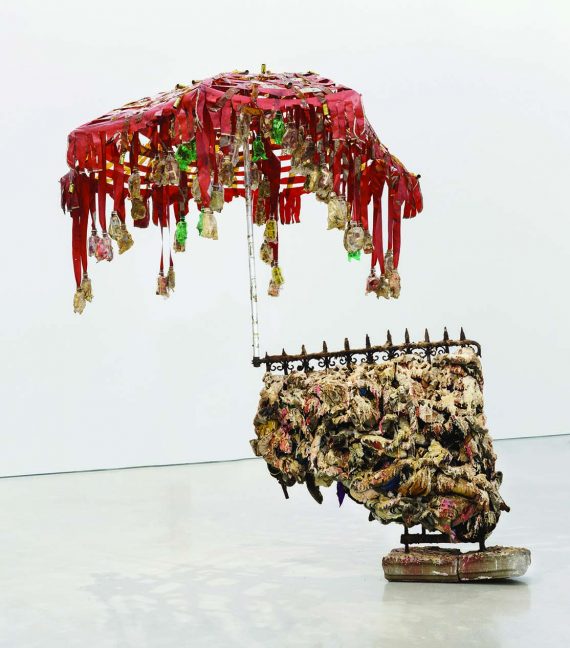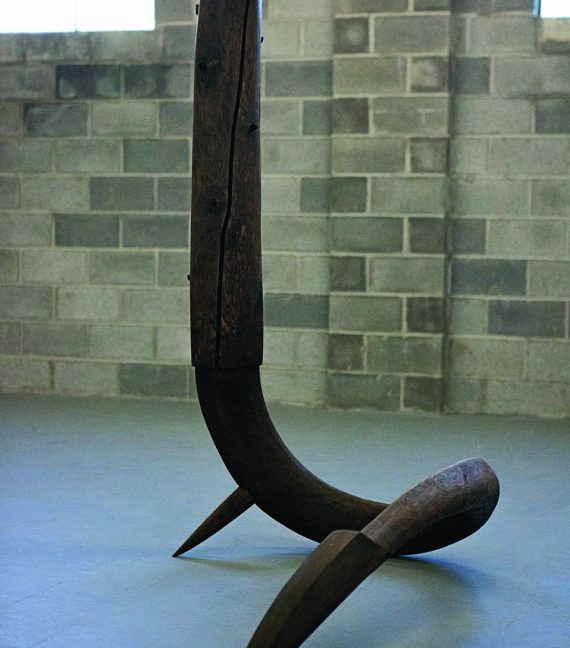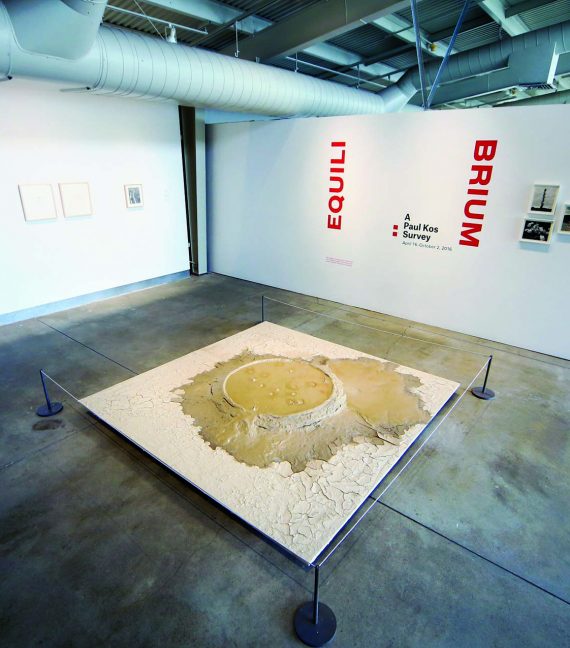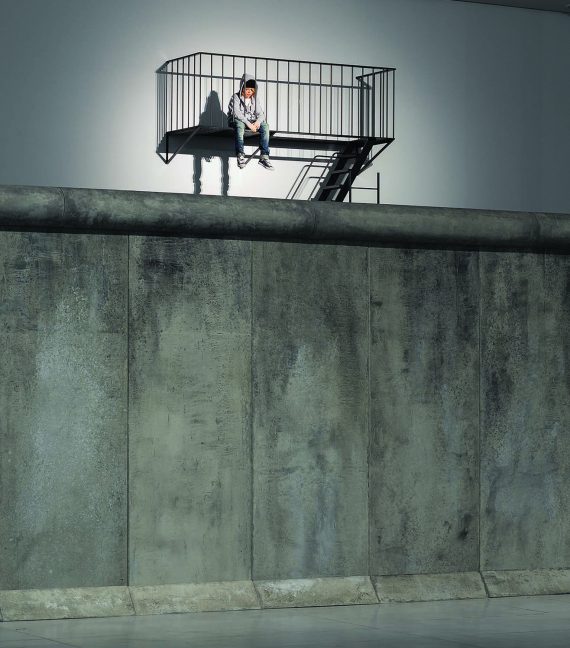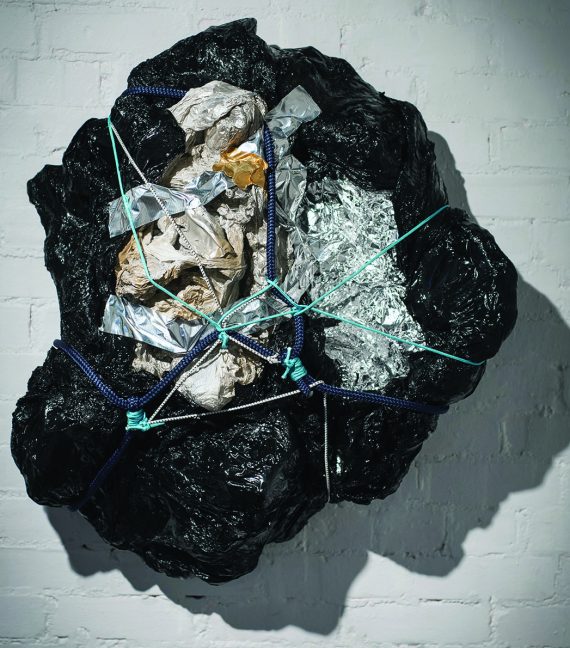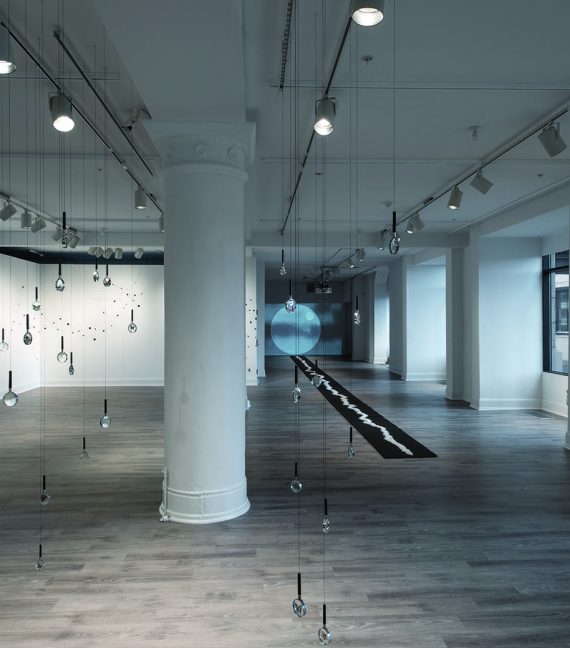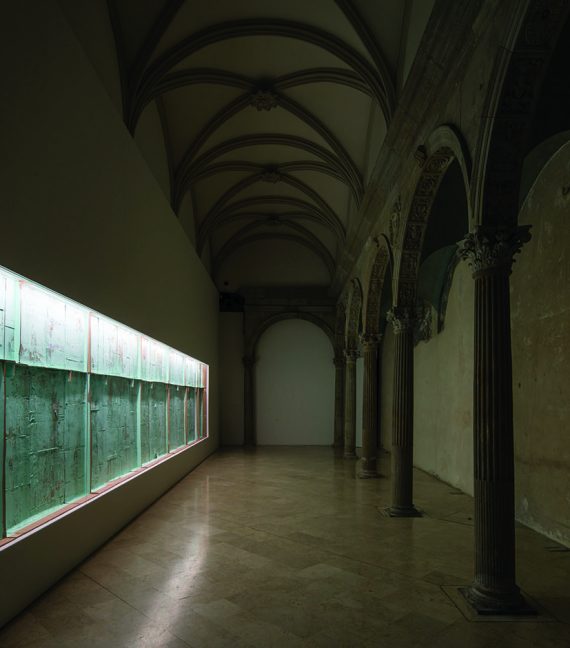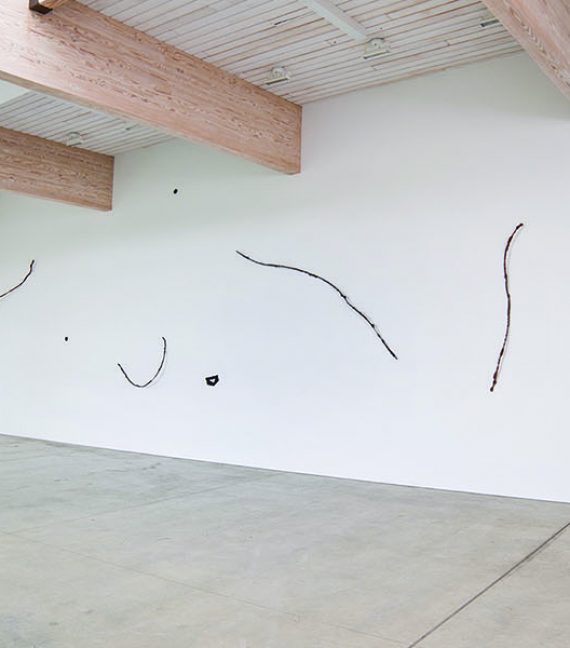BOSTON Boston Sculptors Gallery Laura Evans is best known for her bronze versions of brown paper lunch bags—crinkles, folds, and all. Real lunch bags are meant to be disposable ephemera. Evans’s bronzes will last for the ages. They’re comical. Tucked in a bookcase indoors or sitting on the grass outside, they sometimes make people giggle. While still engaged with the lunch bags, Evans moved on to tree branches in her recent show, “The Aching Web.” These antic constructions had a presence even before you entered the gallery. One of them started on the floor of the large room, struggled to climb over a railing, and ended up on a shelf just below the big windows looking onto the street.
Nari Ward
MIAMI Pérez Art Museum Miami “Sun Splashed,” Nari Ward’s recent retrospective, employed penetrating humor and quotidian materials to recalibrate views about race, culture, and faith. The opening themes included immigration, social justice, the urban milieu, and citizenship. Amid the sounds of moving wheels accompanied by Blind Willie Johnson’s “Dark was the Night,” Land (2002–14), a rootless tree made of a small wheel wrapped onto a cylindrical metal base, evokes the migrant experience of mobility and change. Rock, Booked, Scissor, Vice (2010) repositions a reference book, Black’s Law Dictionary, in relation to the children’s game of rock-paper-scissors.
Jeff Spaulding
WASHINGTON, DC Curator’s Office Almost a decade ago, Curator’s Office led a conspicuous cultural shift by avoiding DC’s usual gallery locations of Georgetown and Dupont Circle and opening on 14th Street in Logan Circle. Faced with skyrocketing rents when the lease ran out in 2013, owner Andrea Pollan was forced to close her doors. This hurdle didn’t deter her, however, and today she remains an indomitable force for contemporary art in Washington and beyond, branching out to organize pop-up exhibitions at different venues, as was the case with Jeff Spaulding’s recent show, “Vintage Spaulding,” at the 703 Edgewood Street Studios in a developing Northeast neighborhood.
Paul Kos
NAPA, CALIFORNIA di Rosa Paul Kos’s career as a major figure of Bay Area Conceptualism began during an extended visit to di Rosa, back when it was still a fledgling vineyard and Rene di Rosa, its owner and founder, was beginning to accumulate what would become the world’s largest collection of Northern California art. In 1968, Kos—then 26 and still in graduate school at the San Francisco Art Institute—spent a good part of the summer grafting vines and building sculpture.
Elmgreen & Dragset
TEL AVIV Tel Aviv Museum of Art “Powerless Structures,” part of a series begun in 1997, was also the title of Michael Elmgreen and Ingar Dragset’s first exhibition in Israel and the third installment of “Biography,” a joint project with the Astrup Fearnley Museum of Modern Art in Oslo and the National Gallery of Denmark. Influenced by the writings of Michel Foucault, Elmgreen & Dragset view power as an everyday phenomenon, with the ability to change or evolve into something else. The “Powerless Structures” specifically critique accepted procedures and systems relating to public spaces and institutions.
Zipporah Camille Thompson
ATLANTA Whitespec Project Space Started a few years ago by a documentary about the moon’s gradual drift away from the earth’s gravitational pull, Zipporah Camille Thompson began to reflect on the moon’s significance and its scientific and archetypal role in human life. The deflection of the moon, however slight, she realized, is a crisis meriting much more attention. Inspired by moonscapes and the satellite’s effects on myriad aspects of the earth’s diurnal patterns—from tides and weather to births and suicides—Thompson’s recent work delves into personal experiences, as well as the oneiric realms of myth and alchemy, to probe the mysteries of life, death, and renewal as symbolized by the moon, particularly its darksome phases.
Harriet Bart & Yu-Wen Wu
SAINT PAUL, MINNESOTA Minnesota Museum of American Art Project Space “Random Walks and Chance Encounters” (“RWCE”) asked visitors to take stock of their surroundings, acknowledge daily encounters, and ultimately, to simply see. Annexing almost all of the Minnesota Museum of American Art’s Project Space, the peripatetic installation was created over two weeks, by Harriet Bart of Minneapolis and Yu-Wen Wu of Boston. The artists first met in 2010 while in residence at the Virginia Center for Creative Arts, where they discovered a like-minded penchant for walking, a proclivity for connections between art and science, and an appetite for the limitless possibility of chance encounters—all of which were elements of their respective artistic practices and prompted the collaborative approach to “RWCE.”
Carlos Bunga
BARCELONA Barcelona Museum of Contemporary Art (MACBA) Barcelona Museum of Contemporary Art (MACBA) Commissioning contemporary art for a historical space always risks a vacuous result. This thought lingered in the back of my mind when I went to see Carlos Bunga’s three-part installation in the Convent dels Àngels at the Barcelona Museum of Contemporary Art (MACBA), but it quickly evaporated. His discerning interventions could not have been less glib. In fact, they functioned as a lever to promote reflection on issues ranging from the complex’s evolving visual, material, spatial, and functional characteristics to the idiosyncrasies of the built environment and the continuing evolution of the urban fabric.
DÜSSELDORF
DUSSELDORF Kunstsammlung Nordrhein-Westfalen, K21 Standehaus Tiny figures teeter and bounce amid looming, massive spheres. Easy to miss from the floor of the Ständehaus’s vast atrium, the incongruous drama flits against a faceted glass roof more than 75 feet overhead. Triangular roof panes recall a Buckminster Fuller geodesic dome, as well as his musings on livable environments. But as critic Ronald Jones points out, Tomás Saraceno can be distinguished from earlier futurists because he aligns divergent realms of expertise and industrial materials with a scalable vision to create physically accessible environments.
Alain Kirili
NEW YORK AND GHENT, NEW YORK Hionas Gallery and Art Omi The lyricism of postwar Matisse and the muscularity of postwar American art are often viewed as opposite ends of the aesthetic spectrum. Alain Kirili’s recent work, shown at two different venues, implicitly addresses this polarity. He first explored this path in 1978, when he began incorporating wire into abstractly modeled terra-cotta volumes. A few years ago, twisted wire and rubber works revealed a fertile re-engagement with gestural abstraction, as Kirili moved away from the totemic and volumetric creations that had defined his work for the past two decades.






